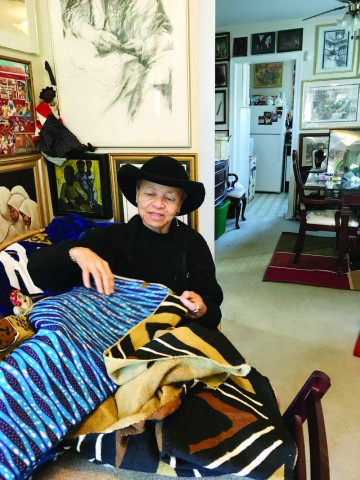Telling Stories in Stitchery
Mention quilts, and people often share memories of grandmothers or great aunts working with needle and thread, joining pieces of fabric with precise stitching.
Dr. Joan Gaither, who documents history with cloth and thread, describes herself as “a quilter who breaks all the rules.” Her quilts are covered with images, words and objects: buttons, ribbons, pieces of jewelry, shells — anything that can be sewn to fabric and symbolizes an aspect of the story she tells.
She stitched her first quilt after the death of an aunt whose story and family history she wanted to memorialize. As she added text and photos to represent the lives and careers of seven generations of her family, the quilt grew to an impressive 10-by-12 feet. It includes the colorful and imaginative embellishments that now characterize her work and features brilliant Maryland state flag colors representing her family’s ties to Baltimore.
That experience 18 years ago launched the Maryland Institute College of Art professor into fiber arts and three-dimensional collage. Gaither has since made over 200 quilts, telling her stories and those of black Americans. Many have themes of identity, racism and social justice. Others honor the lives of individuals who have influenced national politics, education and the arts.
Through this month, you can see her quilts in Baltimore in the exhibit Freedom: Emancipation Quilted & Stitched at the Reginald F. Lewis Museum, which celebrates the contributions and legacies of people of color in Maryland.
Each image, object, fabric and color, she explains, has symbolism. Most quilts are edged in African mud cloth. A strip of blue stands for the ocean passage. Red, white and blue fabric represents America. Pieces with railroad tracks are the Underground Railway and the flight to freedom.
“The strips are often held together by safety pins, some still open,” she explains, “to symbolize the pain of slavery, oppression and injustice.”
The topics of the quilts on exhibit range from Gaither’s personal history to broad topics of national interest. Laid out in a pattern like the Maryland flag, her Sesquicentennial 1864 Slave Emancipation Quilt has blocks that represent all of the counties in the state, plus Baltimore City. Each block focuses on events and people associated with emancipation. More than 400 people across the state helped in creating this quilt, which will continue its travels throughout Maryland when the exhibit closes at month’s end.
Collaboration is a hallmark of Gaither’s work. She brings together local communities, school children and church groups to create and construct quilts. One of her largest quilts (10 by 14 feet) depicts the entire Chesapeake Bay and celebrates the lives of its black watermen. That inspiration was, she says, “my discovery that there was very little record of the contributions of African Americans to Bay-oriented industries.” Individuals from towns all around the Bay contributed information, family photographs and objects to make the history come alive.

No experience required is the message at Gaither’s quilt-making workshops. People come with words, photographs and mementos. She brings ink jet printers, scissors, markers, boxes of embellishments and inspires her quilters to capture memories and stories on fabric. Sewing is done with large needles and simple stitches.
A group of young children who swarmed into her exhibit the day she and I visited were drawn to details on the quilts, calling out to one another as they noticed yet another fascinating or unusual embellishment: strings of beads, a political button, a plastic crab. She answered some questions, then encouraged the kids to talk with their families and elders: “Ask them questions about their lives,” she said, “about what they remember from when they were young.”
“Memory aids, instruction manuals and moral compasses” are our stories, author and journalist Aleks Krotoski says. Gaither’s quilts are just that, capturing history, documenting and honoring lives, describing their lessons about the past and their calls for justice and equality.
Follow Gaither on Facebook: www.facebook.com/JoanMEGaither.
